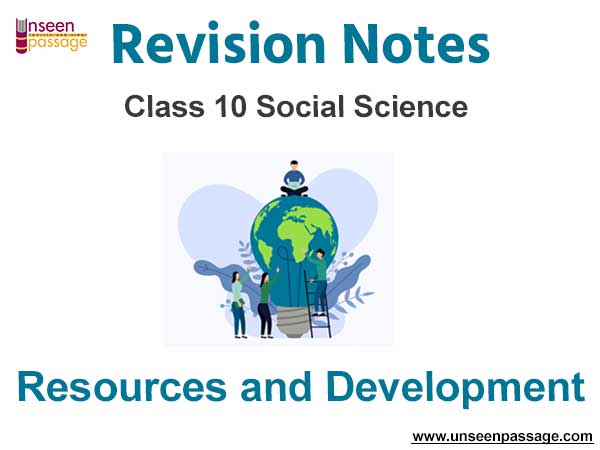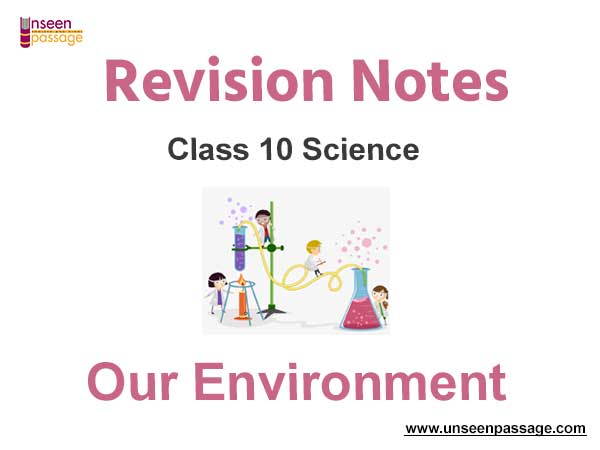Resources and Development Notes for Class 10 Social Science
Following are Resources and Development Notes for Class 10 Social Science. These revision notes have been prepared by expert teachers of Class 10 Social Science as per the latest NCERT, CBSE, KVS books released for the current academic year. Students should go through Chapter 1 Resources and Development concepts and notes as these will help you to revise all important topics and help you to score more marks. We have provided Class 10 Social Science notes for all chapters in your book. You can access it all free and download Pdf.
Chapter 1 Resources and Development Notes Class 10 Social Science




Key Concepts to Remember –
Renewable Resources – Resources which can be reproduces or renewed by physical, chemical or mechanical process. Eg.Solar, wind.
Non-Renewable Resources – Resources which get exhausted with their use. Eg. Coal, Petroleum.
Individual resources – Owned by individuals Eg. Own land, House.
Community Owned Resources – Resources which are accessible to all the members of the community Eg. Parks & Playground.
National Resources – Resources which belong to the nation. Eg. Roads, Railways.
International resources – Resources which no individual country can utilize. Eg. Oceanic waters beyond 200 km
Potential resources – Resources found in a region but not in use. Eg. Solar Energy in Rajasthan, wind in Gujarat.
Stock – Resources available but do not have appropriate technology to access.Eg Lack of technical know how to use hydrogen and oxygen as source of energy.
Reserve – Subset of stock. Can be used for future needs. Eg. Water in the dams, forest resources.
Development of Resources – It means the extraction and utilization of resources using the available technology, to satisfy human needs.
Sustainable development
a) Development should take place without damaging the
b) Present development status should continue and grow in future.
c) Development in the present should not compromise with the needs of the future
Agenda 21 – it aims at achieving global sustainable development. It is an agenda to combat environmental damage, poverty, disease, through global cooperation on common interes1s, mutual needs and shared responsibilities.
Land under important relief features in India – Plains-43%, Mountains-30%, Plateaus-27%
Land Degradation – Continuous use of land over a long period of time without taking appropriate measures to conserve and manage it.
Soil erosion – The denudation of the soil cover and subsequent washing down is soil erosion.
Reasons for soil erosion include – Human activities like deforestation, over grazing, construction, mining, defective method of farming etc. Natural forces like wind, glacier and water flow
Gully Erosion – The running water cuts through the clayey soils and makes deep channels known as gullies. This makes the land bad land and in the Chambal basin such land is known as ravines.
Sheet Erosion – When top soil over large area is washed away it is known as sheet erosion.
Methods to prevent Soil Erosion in Hilly Area
Ploughing along the contour lines – contour ploughing
Terrace cultivation
Strip farming
Shelter belts
Question and Answers
Question. Describe the land use pattern in India.
Ans.
- Pasture land – land under permanent pasture is very low and further decreasing. But we are still managing the cattle population in India by preparing fodder for them
- Net sown area – It is about 54 percent in India. The pattern of Net Sown Area varies from region to region.
- Forest area – It is far lower than the desired 33 percentage of the geographical area. It is considered essential for maintaining the ecological balance.
- Waste land – It includes rocky, arid, desert areas and land put to non-agricultural uses.
Question. What are the advantages of renewable resources?
Ans. The resources which can be used again and can be reproduced by physical, chemical or mechanical processes are known as renewable resources. These resources take a short time for renewal. These are free gifts of nature. Renewable resources are pollution free and therefore environment friendly. Example are solar energy, wind energy, tidal energy, geothermal energy, forests and wildlife etc.
Question. Distinguish between Potential and developed resources.
Ans.
- Potential resource – resources which have been found in a region but have not been utilized.
- Developed resource – resources which are surveyed and their quantity and quality have been determined for utilization.
Question. Find out reasons for low percentage of Net Sown Area in Arunachal Pradesh, Mizoram, Manipur and Andaman and Nicobar Islands.
Ans. Reasons for low percentage of Net Sown Area –
- Rocky, mountainous, not suitable for agriculture
- Climate is harsh
- Heavy rain hampers the agricultural activities
Question. Distinguish between Bangar and Khadar.
Ans.
- Bangar – lt is the old alluvial soil. Less Fertile, it has a lot of concentration of kankar nodules
- Khadar – New alluvium, highly fertile.
Question. Resource planning is the single solution for sustainable development .Justify.
Ans.
- An equitable distribution of resources has become essential for a sustained quality of life and global peace.
- If the present trend of resource depletion by a few individuals and countries continues the future of our planet is in danger.
- Resource planning is essential for sustainable existence of all forms of life.
- Utilizing the resources in a judicial manner so as our future generation is not deprived of them.



